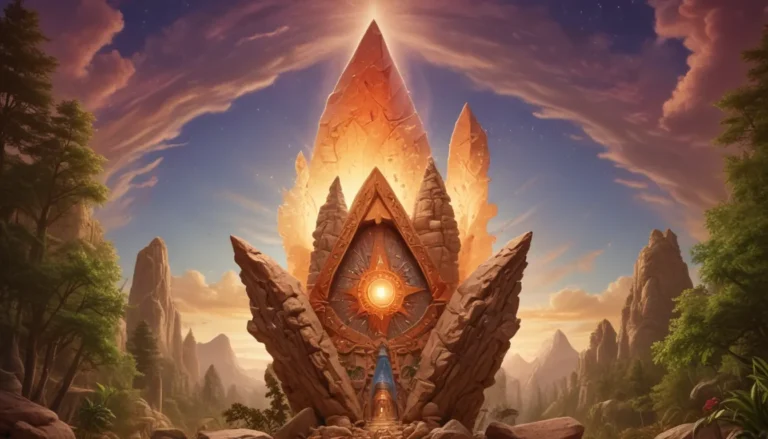
Have you ever found yourself captivated by the mesmerizing pattern of a spiral? From the delicate curl of a fern to the vast swirl of a galaxy, spirals are found throughout nature and have been used as spiritual symbols in various cultures for centuries. In this comprehensive guide, we’ll explore the profound spiritual meaning behind the spiral and how it can serve as a powerful tool for personal growth and transformation.
The Universal Presence of Spirals
Spirals are one of the most common patterns found in nature, appearing in everything from the structure of DNA to the formation of hurricanes. Some notable examples include:
- The Fibonacci spiral in the arrangement of sunflower seeds
- The spiral shells of nautiluses and snails
- The spiraling arms of galaxies
- The coiled patterns of vines and tendrils
- The swirling currents of water and air
The ubiquitous presence of spirals suggests that they are not merely decorative but serve a deeper purpose in the grand design of the universe.
Spirals as Symbols of Growth and Evolution

One of the most significant spiritual meanings of the spiral is its representation of growth and evolution. As the spiral expands outward, it symbolizes the journey of life, with each turn representing a new cycle of learning and development. This concept is reflected in the Fibonacci spiral, which is based on a mathematical sequence that governs the growth patterns of many living organisms.
The spiral’s outward movement also signifies the idea of progress and forward motion. It encourages us to embrace change and continue growing, even when faced with challenges or obstacles. By following the path of the spiral, we can unlock our full potential and achieve a greater understanding of ourselves and the world around us.
The Inward Journey: Spirals and Self-Discovery

While the outward expansion of the spiral represents growth, its inward motion symbolizes the journey of self-discovery. As the spiral coils inward, it invites us to delve deeper into our own psyche and confront the aspects of ourselves that we may have neglected or hidden away.
This introspective process can be challenging, as it often involves confronting our fears, doubts, and limiting beliefs. However, by following the spiral’s inward path, we can gain valuable insights into our true nature and purpose, ultimately leading to greater self-awareness and personal transformation.
Spirals and the Cycle of Life
Another important spiritual meaning of the spiral is its representation of the cycle of life. The spiral’s continuous motion reflects the eternal flow of energy, from birth to death and back again. This concept is embodied in many ancient spiritual traditions, such as the Celtic triple spiral or triskele, which symbolizes the three stages of life: birth, death, and rebirth.
By recognizing the cyclical nature of existence, we can learn to embrace the impermanence of life and find peace in the knowledge that every ending is also a new beginning. The spiral reminds us that change is a natural and necessary part of the human experience and that we must learn to flow with the currents of life rather than resist them.
Spirals and the Connection Between Mind, Body, and Spirit
In many spiritual traditions, the spiral is seen as a bridge between the physical, mental, and spiritual realms. Its three-dimensional form represents the interconnectedness of these aspects of our being, with each level influencing and supporting the others.
By meditating on the spiral, we can visualize the integration of our mind, body, and spirit, promoting a sense of wholeness and balance. This holistic approach to spirituality recognizes that true growth and transformation require the harmonious development of all aspects of the self.
Spiral Symbolism in Ancient Cultures

Spirals have been used as spiritual symbols in various cultures throughout history. Here are a few examples:
- Celtic Spirituality: The Celtic spiral, or triskele, represents the three realms of earth, sea, and sky, as well as the stages of life. It is often associated with the Celtic goddess Brigid, who embodies the creative power of the universe.
- Native American Traditions: In many Native American cultures, the spiral symbolizes the journey of the soul, both in this life and the afterlife. It is also associated with the cycles of nature, such as the changing of the seasons.
- Ancient Greek Mythology: In Greek mythology, the spiral is associated with the labyrinth, a complex maze-like structure that symbolizes the journey of the hero. The labyrinth is also linked to the story of Theseus and the Minotaur, which represents the confrontation of one’s inner demons.
- Hinduism and Buddhism: In Hinduism and Buddhism, the spiral is often depicted as a mandala, a circular design that represents the cosmos and the journey of the soul towards enlightenment. The spiral mandala is used as a tool for meditation and visualization, helping practitioners to focus their minds and connect with the divine.
Incorporating Spiral Symbolism into Your Spiritual Practice
Now that you understand the deep spiritual meaning of the spiral, you may be wondering how to incorporate this powerful symbol into your own spiritual practice. Here are a few suggestions:
- Meditation: Use the spiral as a focal point for your meditation practice. Visualize yourself moving along the spiral’s path, either inward towards self-discovery or outward towards growth and expansion.
- Artwork: Create or collect artwork featuring spiral designs, such as paintings, sculptures, or jewelry. Surround yourself with these visual reminders of the spiral’s spiritual significance.
- Nature Walks: Pay attention to the spiral patterns found in nature during your outdoor excursions. Reflect on how these spirals relate to your own journey of growth and transformation.
- Journaling: Use the spiral as a prompt for your journaling practice. Write about your own experiences of growth, change, and self-discovery, and how the spiral’s symbolism relates to these aspects of your life.
- Embodied Movement: Incorporate spiral movements into your yoga, dance, or other embodied practices. Use these movements as a way to connect with the spiral’s energy and integrate its lessons into your physical being.
By incorporating the spiral into your spiritual practice, you can tap into its profound wisdom and guidance, supporting your own journey of growth, transformation, and self-discovery.
Conclusion
The spiral is a sacred symbol that holds deep spiritual meaning across cultures and traditions. Its universal presence in nature and art speaks to its significance as a representation of growth, evolution, and the cyclical nature of life. By understanding and embracing the lessons of the spiral, we can navigate our own journey of personal transformation with greater awareness, resilience, and grace.
As you continue on your spiritual path, let the spiral be your guide, reminding you of the interconnectedness of all things and the inherent wisdom of the universe. Trust in the process of growth and change, and know that every turn of the spiral brings you closer to your true self and your highest purpose.





